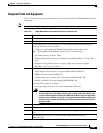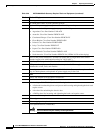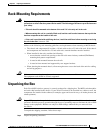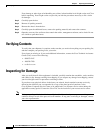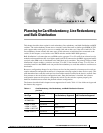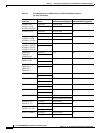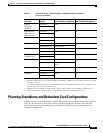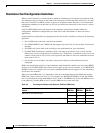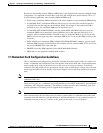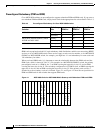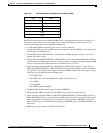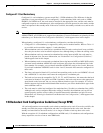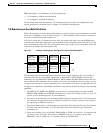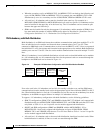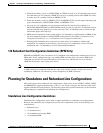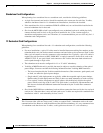
4-5
Cisco MGX 8800/8900 Series Hardware Installation Guide
Releases 2 - 5.2, Part Number OL-4545-01, Rev. H0, May 2006
Chapter 4 Planning for Card Redundancy, Line Redundancy, and Bulk Distribution
Planning Standalone and Redundant Card Configurations
Because the relationship between PXM and SRM cards is preconfigured and cannot be changed during
configuration, it is important to install these cards using the configuration options listed in Table 4-2.
Use the following guidelines when installing PXM and SRM cards:
• When using a standalone PXM configuration, the switch supports a single standalone SRM per bay.
• For the MGX 8830, a standalone SRM provides services to all cards in the switch and must be
installed in the slot that supports the standalone PXM. For example, if the standalone PXM is
installed in slot 1, the standalone SRM must be installed in slot 7.
• For the MGX 8850 (PXM1E/PXM45) switches and the MGX 8880 Media Gateway, up to two
standalone SRMs can be installed to provide SRM services to the upper and lower bays. For
example, when a standalone PXM is installed in slot 8, a standalone SRM in slot 16 can provide
SRM services to the upper bay, and a standalone SRM in slot 32 can provide SRM services to the
lower bay.
• When installing two standalone SRMs in MGX 8850 (PXM1E/PXM45) switches, you can install
different SRM card types in different bays. For example, you can install an SRM-3T3/C card in one
bay and an SRME/B card in the other bay.
• SRME/B is the only SRM supported on the MGX 8880 Media Gateway.
• SRM cards are not supported on MGX 8950 switches.
1:1 Redundant Card Configuration Guidelines
The 1:1 redundant card configurations provide the optimum protection against failure of a single card.
In the 1:1 redundant card configuration, one card operates in the active mode and a second card operates
in hot standby mode, ready to provide services in the event of an active card failure. To minimize
switchover time and prevent service interruption, standby cards are dedicated to a single active card and
cannot support additional cards. Standby cards do not support services until they transition to the active
state.
Note To prevent total switch service interruption in the event of a PXM card failure, Cisco recommends using
redundant PXM cards.
There are two types of 1:1 redundant card configurations on Cisco MGX 8850switches, preconfigured
redundancy and configured redundancy. The following sections describe these redundancy types and
provide guidelines for installing cards to support these configurations.
Note The 1:1 card redundancy configuration is sometimes referred to by the older term, Y-cable redundancy.
This is because older card sets always used Y cables to connect both 1:1 redundant cards to the same
communications line. However, with the addition of APS line redundancy, it is very common to have 1:1
redundant cards that do not use Y cables, so this guide uses the term 1:1 card redundancy.



